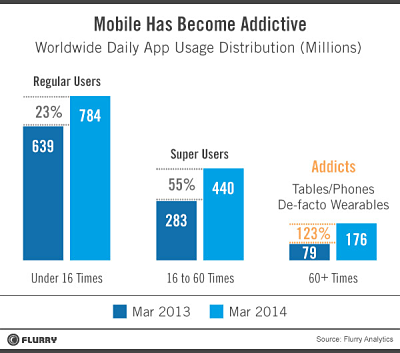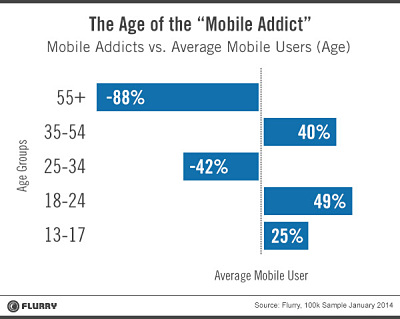Consumer connectivity to mobile has birthed a new type of user - the “Mobile Addict” who opens applications more than 60 times per day, according to a new report from Flurry.
While the average consumer is launching apps 10 times per day, the Mobile Addict is launching six times more apps per day. The segment of heavy mobile users is growing faster than any other segment, up 123 percent in the past year while the number of Super Users grew 55 percent and Regular Users just 23 percent.
“This is the first time in our lives any marketer can engage the consumer all the time,” said Simon Khalaf, president/CEO of Flurry, San Francisco. “Marketers have not seen a medium to date so connected to the body of the consumer like mobile."
“The mobile device has become a television set in the hands of every consumer, and marketers need to begin thinking about advertising on a mobile device the same way they would in a broadcast setting,” he said.
In "The Rise of Mobile Addicts" report, Flurry Analytics announced it reviewed a network of 500,000 apps to draws its data from over 150 billion app sessions monthly from 1.3 billion mobile devices worldwide.
Implications for wearables
Data reveals that the average consumer launches ten apps per day. This also coincided with heavy increases in digital consumption for the newly coined Mobile Addict— an individual so immersed in the mobile realm that there are few distinctions between existing smartphones, and newly developed wearables.
As a consumer who launches six times more apps than the norm, equating to 60 app openings each day, the Mobile Addict shows no signs of yielding consumption rate.
In fact, it is quite the opposite, between 2013 and 2014, Mobile Addicts grew 123 percent compared to all user segments. Last month, there were 176 million Mobile Addicts, up from only 79 million from the year-ago period.

Addicts are increasing exponentially
Flurry's data showed that Mobile Addicts are 52 percent female and 48 percent male, compared to 48 percent female and 52 percent male for an average mobile users. Meaning that females over-index 8 percent compared to the average mobile user.
The 8 percent number may appear small, but it is significant. In the total Mobile Addict population of 176 million, it means that there are 15 million more female Mobile Addicts than male Mobile Addicts.
Concerning age, the Mobile Addict segment over-indexed on the teens (13-17), college students (18-24) and middle aged (35-54) age segments.
In fact, middle-aged consumers constituted 28 percent of Mobile Addicts, but only constituted 20 percent of the average mobile consumer. The Mobile Addict segment under-indexed on adult consumers (25-34) and seniors (55+).

Mobile Addicts persist in younger generations
The quintessential Mobile Addicts are not surprisingly teens, college students, and middle age parents, all groups which expect the most out of mobile devices for daily tasks and communication.
Also, the reveal of young adults under-indexing is quite predictable, as they have presumably entered the workforce, are predominantly single and on-the-go much more than older and younger segments.
What is striking, is the over-indexing of the middle age segment. Flurry discovered that this group is most likely comprised of couples that share devices with family members, including children.
The future of wearable tech
Mobile Addict behavior patterns suggest consumers are using devices inherently like clothing. They will undoubtedly become the early adopters and guinea pigs of wearables.
While much current wearable tech focus on health and fitness, developers will need to think about what awakens alacrity amongst the Mobile Addict segment, a group that requires constant attention, becomes bored easily and is interested in accessing critical tasks from the palm of their hand.
For instance, although watchmakers may be avoiding jumping on the smart watch bandwagon, the horology sector may benefit from other wearable technologies such as Google Glass.
With rich heritages, watch brands pride themselves on innovation and detailed craftsmanship. The incorporation of Google Glass, or similar innovative wearable technologies, can enhance the consumer experience and bring traditional horology into the future without the chance of product dilution (see story).
The adaptation of mobile technologies to appeal to the modern-day consumer is a force of constant evolution.
“Traditional marketing consists of one-way communication,” Mr. Khalaf said. “Marketers need to realize that communication is now a two-way deal and engagement is 24/7, 365."
“Put it this way, if you have the chance to speak to your customers all the time, what would you say,” he said.
Final Take
Michelle Saettler, editorial assistant on Mobile Marketer, New York
{"ct":"SlE681Rd6N8zMXjt9xqLpGlWTZdF4MpDeTnOJ6rkxnBWWY4lf0nmcoYwwI7hOlCSn+\/oZ2sYfNEhN3OAqFy65JeIAD13wj6f4OzxmHwCshllEgL4hWxlcbF+68EUdb7ZQTIQqseah891OiMBa9Y\/cdkmolqkQrKCMYUQ3jSbMIeeGATLHLw3QJNnwdGbUF56RKtMka+eqiUmrRau0LKPvONzq9I9uwdwPq2\/F31ydwxuGHJHrqFKFqL4796M\/8Z\/H0kyuLI7ZhB0lK0W1heWYs60d9AtRHL9U2KbWF+KYjjAYozXr78Cc3OVp4JDwiiT06kZJJXXREnTmKk3MHikDO0noLbCwBNtx55VHUXfJjMsVPzpscoYQuDOLjfR3qGBW6hXLlq9tngsJ7vZYvwdLdmteZybsA4cmAhZ0DYA\/EYKUIWJQ3BtOHgvyz6NRFKZzhrwysIjFT7efEiTkfkRxz7a\/GWf3GnP05jFrcS4n\/CDXaQpxN8HWHmkytEWllpfIZH7f1xgYY\/bUHVMjoTY6ycZEALR46NlSFnY5bTNpX7+8F\/7n2RFvC7VqpH4Q2wAU1Zf5+fUuaFr0+jc3md8YQpc7GMTh7S7qm5TDKOhw8tSVyUK4wSOFjNZrFMDqpCJtehmDGBO6f4O7xUqJnrNN9KRv1YaHmv4mfLBNFkaDbnS+KsGZr2WfIqjtiT1ibH+HpB3fKiptxqugotGt1EOTLTrSkHChWTn6moy2DubLuvHhpyFILhkawEcIOSZW2SISxVYiFdvfnOXnTRPrtl46C0rWGQoG85iiAewLDEhXWh4UYPV5+ONF6cDvQA0ynQGlTF66qTu83mkzQJo3FX\/ujJ\/45p5XLv0ZGYiZQ1Gk45QyG7NB1sEnotRYZhPdno7LaC9g7VI0c+pGX6yhPRn0ebPyHm\/GtN9o\/RAW9FyV\/8YW0pXeqnXWN4M1D7qp1PvgiK3j3kQsFM0z9ir62umN0nnZoOfxEj9xDEYko62nteF9nswxvM73Ja6CMGl0Wsu\/alO+6GVADVyWJV2Lpp9sEqdptMNgJt9eiOPusUHgQnBCukmIYFMhjy\/6Ng9Mm5fwTyb1tpoLPJ85eR2Rs4R8KeLO4li5xDne3LDkjIBQAjv\/1Oaf8j3eQ4nqu9I3QuNSVUoK43EId9VGW31jXDZJ5ggnh34Vruws6PlruS7z6jHpHCDqdCoZYD5TRrmZfuRCJ77\/ZZhOXrwrCck73UGt13vhjdv7ZcNrap\/NhzKh8NOGcYm\/NyOACGYEfSFUX5AFLGW73jYESjVjL\/CrxN5k6z1op5wgY3SWbSczMZO1GIzdHCu3\/r07TqHdDdS+QPUxRTxKinf8GBanXXOJO+bSVqEPehKM8gNi6AA+OErB29SbwXoqfJrqUVZmB6XlqO9\/9k7Gs62+BY\/A4otAQaCtpLvzLP6Xtr8uu6v+YNUNvacJPA3wH1b4ootJ1UXR6LpvivvVZUKCzaSSFznk95R+IX3pMX+qwlCyfYQqG6EkhAkmkLDI\/xHBK\/KKB2hr4XnpA5CORDHvlS4lE6fxdORFaxMfu0+HdtBGRcloqfjO3LYFhtte+qdKIWKmuAGbYgGz8bLabz68VhwaGUQMW5T8p1KNMkdLx2cc3Hdx+SndCtZalDnTctfRenuDo6vcxqxJ4rKMmtObV5uDFgjm3vLPa97HZlbaezW6mhIifuGn6rcVW47nUa\/0thttspEQwzPFkGeIpeLqF0YH6jPNXNO5pQaypoHla7FaxqaYhB3RyzZd1njHFZxfjIZou\/KuVmg2Zul1yu06hTktikyHoz\/Y163Cl5PYmdVT4rCc9OUzgPNkOI35Mt3Y7SkMFIxDULGWYNbl1\/wSazVznBNVRCq+s5JZoWts4FjdNH3P2Qz++FeITxHFRxqqtuivyOSqKpMDK7VTFAwhdojc7b0UuCPhfEEfuiGBHE0I3KV+ptV+Xo2kJwkzlqrvDm4eVmPZQriT0YPdv0Y11ctHzia9WpPq6jW74tM82hT7\/x72AJZPHA+qAv4gC6CE760baquXesMCCg+YOao1uULwhDU0RRc\/0sO6RtXIXE21hSvmQ64EOc2cqmhoerxKbP7DzCBmVzP4i0pcmeTJhCaMQNgy4Zzkq5h91JPKo27SqHGD6bO3+F7I+a8yEminCj9giKA3Fe68OzzPrJ6L1894ADMmNzmO+RpQuJZBfLlJNzPy2t90hH4kuIGmARbe7Xirg8RBxuF2YcQf6OxglJ2lT3iFpQnsiKEGtCloRoeqcRChNKIkilp0SO\/+0eUqs4JyV0sK0mVlx+LEnuNn3aBQ+eBgM6U5emRAz8kxn3LfPAQjxWxpVj\/pmKqP39BHMWYhbirgLxz6VZsEb0rpppksCmc3vquzjiVi0fPIKrv7Nk\/G9411s321Px7fsGrMwUtmTEFhDK2Jg4mg5gJ2m2ZHkGKvLK71NA4M+Y7whrd\/eNXs3hQpMdNb19rh5AdBWWH7mbY5rCP70xjiwcVq9YZB0XtupsBnZ7E2G495yrm5ykirmFuA4PstN4NnpnULFE1ypBp2Um4hXDpIJzcuR57xV1F3y55zXClaWuh96wanvuLCI+v9qIwoSy3thy+rQ+jM8GrCAIeWEiT5F5HKUwrodCf7HGiFzbQB4Fdnv0Iko4YzytpdO0KWiRQ\/sCPfTAMB8Vo7KSQStv10m6G4fQIJm11S0qH10ce7l9x\/7nkn2xgn6MBLxWrB8g+2dwbNtT33eKkM4aDRaoH\/JW4w3RjupfrOfe047UcpUmAXT2THFEphGBRTOf2UtvWvDyvMHBSz1LxNpQ4JEirF0LWg105RHa6qlF+a\/HSQY1foTx6P5GdydjQui0NiO4z5mcJho\/XMwo7DJy18lRqxXUF+tB3bUX9AOA0EnbZoTodH58j7CAnfyF67PffBOokbFh16svNPexCrHSLBLehr3w\/OFk2jzwx\/Ob6qa5+6IERZrdNyroMbL+5ksJ\/Ydf0D24eElnCBwm06YLr52kZJltQPgqV7yiAYLT1NCcCaFV\/z2TsGaAh8De3GVqXBAWd3ouB5IAw4g1l1vEtNL\/2qqQEx\/vKfGLhHnAPThTObMhl3cXbulQ5ewHo+iWLHbN4+FzvCbkxd0RK5ru83LYmsL3M9vmBZBWskyX77XTQL7XNKuNJbwi1uQbuKOzD4Xka\/LkrKeVyPWEiGI+gdoQxFuuVQUM4RsKKbkgHbqncOoU6jklo5u5kmXHGWJcmSPyPqlUKoKuzaHKeDH4zJKzF7fuHedSmM5\/LN13IyYnGgXjHeJ7AM5+WS8izjXjdi3sNEPRljxIqST+QaSPAKjDv7DWYqeOTlP7xXEKTV92x88QfdqI+k8ACEo0ZaLxW9OV7\/Jbq0nVpDabEMYjWJvLUIFT5nYGSBMLxoPdqvDJeET8WC79FrKxvHSl6zCE6Unaa0W74XNFpVE0CIX\/y12vvEwX1gL87eX9T9f8PO4TZmaxDAjX8Ddz7HClv9F1zp+kUruqgbhxYsxWjMsYnh8biT4miC92+T+MmreUaXIbOolgOIcxpqD3xalHwZsCPY6iaesjXnyMWgRB9yTwvHdJNrF71a0O6rqLBnYlOV08wXWMvmExZ0d3Q0D5SHuiP3TYKiP5IQjcENDDobEdvkErFwFGnlr86UpLo3b7nAaoXRH2abMqUuS+jVorYGcN5VeTWxuTSDEGexdUhVCV0Yo9LQL+wV\/XK6B1cFzsJWwXKmA8GjSX97S+H5uoUOgpZIRWhDvGy2HoKBFTypHlma66+gsChnvXN9GU04JieNiRclj1\/KaHQgXKYNSXST0ViBPY97AeEgafxo1YAShOAIBUhGTZu\/NXGcIPOnCJQAhH9CqVWD09P2Gvt3Phc2NVUQ6uW0r+HkmaLI069NR4qI5Uqfh01K\/nQ0O1e6kWBhKui0MRG8S4Davvt6+iGEuazcbnG27Rq8UidQATDdO\/Fufd0UUEN6ufHBegbz6Qdjo1iGnO6RWgDR5FI+\/TfNmCzZHHy6HvNQfCzOp\/RCE56+pbVa\/4kDydy4j3uXOeFvGyBNU5ASPq91O2LJLlSY53+YDq5G4QWuKEe9YGn6vXI1zkj7FTcfnPO3jxkGAV8ofk9GZl9Cv3u6cgH847Wy+ah\/yK7E84jdoAhNb47wE1325cqHCRFoQ+9L0xEwuukYdWt1SFCST+mG3Xmadb7V8SR7eCH2o61+b98AcBGcYdya8y8T+x96GvSYyNLhpAenAaX1\/kxJcup0gDe3yDuWHJ7GBWxSKWUlP08XnXmb+BH1OL8eG1Ygw31wwUdXlRInlchQLGmEUVGMniOh+H7CXVr1xE09OxaqJ02xQmGrweYND+LuEmYbKBk1SRH414OHFF8X6poRm\/nVGljx0tAHJU1BsRYgZhEfKcBfi3HVujE1WHq2SEOd51vxOJq5q8SFYXzu49GA90x25Zo5JG3AGPgWRJQLrOifPdonxtobDjwZ6+86vaJEpihGccoIgywUO\/XpO8v1JxYrLqC8eO9ZzEIrbmB9jAA9Sgk+FnrP\/DPlKCkYywRZEpmtJsS6ECXe2pjPNQvQu\/k\/sSyBDvD1kweZgFj00okHhwOfjkocI1y\/euVao3Xf4xX5OJIEIeCFqxdMO9jyS3scDevkHd4COd6qPNkrWvRr0MLrBDSHapJSLamMbowq6xf5bb8f9Ss\/2gcV0gDDfbfpI70k0ytHC71tA7vb9amH7LZuC\/KBm2BRJ6+xnsePs\/H3v1lJ39mpr0fRC0aA7ay3yfqZYWpDW8u9DEozCPtT+XGYreNA1UWS4QSscTmchCqDnbunmhVB7aheU44+q5LJI8iGtI2wXdOAlUIUhJ+\/QqD6ke+gQC5DkVj\/jD4cGpaDudb6+cIRXDomj9jRF49GoOo9vVg\/qllQxaKBKEAYR2ar8UDryS4q58vHWzpIaa2di1wq1ZGWDucS+MPXFKZugvZ2TQT+4UUoMYO\/xtWR0\/cciRkcQBtjgezreDj9bU0uxcMJKO9Ddvd8Zh\/1of2L+l3Q4lVytyhzyTR+D6\/moa2m8TbcUTKk6pJg8tVeDQ5aYapNljUAdRllK3nCJK8NB5XF7neitlBfUtfiLST5pA2vYX3zhVQLlPAhAdIPpj+FdroT39ph3BYS8hVogNDC7QbIKgoImSEhS9JsCg3gzY0tNnhUlKnrDxy7IHT6BUPvmsUu1N6OLgjmFO2qutoHutyHw38aXJqe6TA0JeP6EDWoRJKLBP6v6gwWWUX\/eFirq1dI5GKPa44PYdZ8mGRgBuldE+\/pfLi5iU1FeFwmQh3VcezRFcTK4sU6bDtlO+SyCUU4hXFuas+PTSS18Fyg+7V7d2OQUjZFCCEBrYGyRWk9L73nk1pB2ShCgyDGdLZn+jrlhx5L3e\/BJPLVQw8qQNwROsEvmb\/h5RiOa7UjtIFhOmIkZavgxFCK7YVfeXnW6CFgC6hc0ws81aaHQs3zMW0MsviHnXGLaas6+WJjdUYRYCETRwH9SpvjBzxjHSrd\/q9yk0GVpW04xYpj19063mv1kFqTigoRHc1+GgsGzHnXSs2Uj7Sb9vT2at\/pSjAxaRRb6h+\/Ab6bhfu7Th726Yg6PG1ZTkIzy8kc2fEA1DdRLMdifddaM6Uv8Cs\/E4zgm7rjNAAFCYGNfl3C55A\/mTXWcUBfq6QyooIi5GPTzWz9UVBFWOPgfC3sIuN69orKQVWLnn8P4bBQ\/jt0TK6NVZ9shh07lDasY\/wWw+nm816wDhaw\/RHCtIX8iyNVoa2rMZGJPoju8zrmrxQFUMaA0GM7LHcpQ0V2YKpZrmjivAktsR73XMIpbs0uQT7zTQYIzc+OH3bx1lqBSbod5WzavWVRw1+tsAhEM1CdcG8xHdl\/t5f03P5WLHybHnXcvvk9J15aBzE\/16NQvUrpz6bLdp6m96oGLKfZhRc7ffN7Mybt5xg7suqLO4Ruj9hoETmqT40e3cgI\/de7JNgk2HuonYW8ely9knPLB5Ab9otdfDmtjii9TBvN2UDT8K0NjJbBvsSxQNGSYRC5R0Gh22SdXQDY4g\/nUFXAoSM7GfM92yU1vg2nyNlTK5V40vlYuKgAlnHkXTotkBYPw4Rb7pJlm1pPOpbEbsuj9p\/hUyKxB1Sgwi+4AV1Kk7rBNdqoU5eYQIBtcN4wEYP4W1qmPrheiJjJ5ysRp5rdbV667F4643PCmZDpRwVAv33k4\/c1KNyYeiMRwK2isbm2mNcUrpquyEEQaWADukOadMhFq7sobNnvyIeNGcScQsQnLegg9OOVz8xOQuC+ZNoHVgjAX1yTueY848yrOkuQ\/yjX\/d7OGQoEHRgn8g1mdKUO3dv\/6y+wO8P\/WFcSvBS+LfKCOWTvLJnVRuW8ZDXHcjaJz0oh8cx8KKz03gQ5K346vOjhVZlbR1tQZ87fRS02hNKxWDlqjW0jYb5m+MY0jQxIjUZovjRvOcg6Vu\/OT0WsZWsAeWuxtbtbm4sKY0IOhB4LxUce\/80VaRe3NjiFVRNyQhHEv\/MGvni3P11spvPyt4Yuu0reOVAWHciMlAugPWcut79Ly6AfUyNxuLZ6ZnY3KC8pwCxSrNgw818qUJ68MEQ7pVqoZXu68HsPWS2VxUnyOKSWCPYAk2uD8OHWmquvY\/t8JE24mriiq15LJpvUsVNVa0FQ3o6aTPxFFHNkyichRxAmISqJqHYhC+URcBgt+UK2PsutmTyxzizi3ApknBuMqGYfXM5kALsLYcMjncrKVy2ctsBmdNCxRpbfsZimV7b+YWpHocgmzkmSiScoQrSUdw+VPzLwzmTkyN0K92K48+74MC+lRml1FnxYA1yzmJXFHHnUQV4J83hunx43H\/fBZjW5QosNJbt\/+73JcaifuOyimYOHlClJbhpJxdqK7JwO+YTDTqnwNNN57vMv5W0\/l0h8UV5EwMBsd5TzRTAvNtYGOq1sB49JGgzpHr1F\/7U7XzMCL3bsG9MiWgIgO4BjpZMaYEeSbkr+ACQ5nYW\/fmNunxMupt7g1evtfVw3NOHbCSkU5Ld5VwolFYWsUTrHJGoOjkSX+Ci61dNt+3cJfsyQ2q04nVrwB\/eQCIGCHW38G0XFpFmNFDRChH4CsfoYZV\/2uLILr4W3jf2HqqBJWrWvrEpN8KouUVD3ViV1ytH3z+mhAx5pd4Gfj43qMBmXCL4jcgksxgQSrCfUMiGjv2\/f3lyMervs6w+QitNZxgwVTcvzj\/lmf7vs1sWR+7A\/wkRsGa7yS8bOopl+sJH1enDKCUKxq1I5hpSgVELCClNDW6UB02m7YRG65lT5NBK0kytgjPvqpCNWpHziTRrDEUzhO2gGXShXFWBC4jWO4+emrFDMq6i\/hqPzH1dghOMx80rE9zI8OdvSIy4RMfnZ7MkYHg6M6FPBu3vc6gJyQU7yGhsVhhT4Dlp82iGE9ySzzvEy1I5IT9KHo0bSEWChOdftJ3XuSJY8R6TylC7FeArAPniVbbEyqLHhdYovkMuKFVnuFAz8Q36Mui2PiVa0QBcMePwQvlv66ycxe0Wygbd1XW7gph80F+RgI2N28p31rZEelPVfYIXurpZ0\/fPF1sgKkhFphSNH6FQulQNfW4tRFYeaU\/UsyDPNbT5MwdGASm8uDycAiml2oeuV8uKrfOADrEkYk4+qM9taEQSifq0bF\/4RlcTgOT275rHanpYIdH1sTl+qPADRUoXqoKuYZXnW6DdQ1UaUwr5H9Ez5EmMc4oscXqaNEV6caSDxCclUJAGpK\/3gDKl3cnCJ\/ppzc6bLGQVMNkq0+56hnge1ceFcZx4sO4ESN76AaTmOxA34LfTBlBNb991o7NdOHuPhkMDmLOXay3mkR+TBdmDUaT+Xdp6zDRbcpnczy5bSHkmrqH8sFMEMziH5WZwCDm0K2UFy2gptdxt7GNWZncXUL83d8RSLJbeJrKs3mdI8278SmNODjHNeu1TQ09MWxK7Rg7qoPL6My6h2u+IJVfUMdRHwd4yg0JEoBYkhCRq1pFianzDjxjJMNd3WQrEVIklwGd0Z7el5nX2MRoG9SBZvcREUElm3p9oMfBF9gp8kn1QLhphMGf9NdYXF1TxUdxWbWGg3ZlP5OTRlc2oP55NURmQEsp3J3YBj3SYMJ4MX1d\/zDd\/F8ROWPBsbJw+04nE3XHQx5t5uZ9eCiY38ilewkd+Noahum+8SDBbTUFb7FfFH4c9ijdzskpMrrkiuNUYRmItBCK1GDXXqGltE+j4XzjOzusFWt3ck7o1UFw90UaXfQ8P5LWkQ2lSG\/lFmxUT+kAWhl1HwjmbbrMvtKB\/wyt\/uUAhRz7o7rZBEIue0+YKzrKocr2X7fh7wmxK5xx7w5Kav2S3hJoUrQxepec5eC78uGsySq0DJANMxVG\/XV8EjoTJGIBhXMMKv40jgVu5QPU9KX2nPgZauU2Nl2vakzuXzxzHcociLnN4","iv":"8898646b105660e9aa5e55ff57309fcd","s":"3aed29b58304d02d"}
